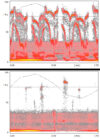electric vehicles: Prevent failure of 800 V drives
Currently, 90% of the fleet of e-vehicles use the tried-and-tested 400 V technology. However, as more and more vehicles with 800 V drives come into the market due to an growing demand for increasing range and shortening charging times, partial discharging will become a significant challenge in the next five years.
To date, FEV has carried out several tests on various vehicles; partial discharge was detected in almost every model tested. To avoid PD-related failures of electric drive units, FEV supports its customers to identify PD during the development process and initiate appropriate countermeasures at the earliest possible stage.



